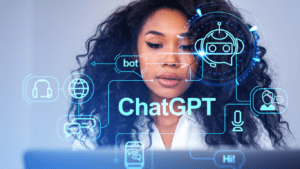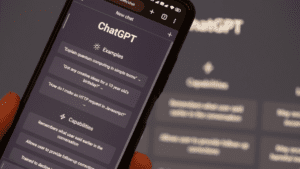As technological capabilities progress, ChatGPT represents a leap forward in machine learning, blurring the lines between AI-generated content and human-generated content. Its applications span multiple platforms, providing customizable experiences that are increasingly difficult to differentiate from interactions with human beings. However, while the positives are numerous, deploying AI on such a scale entails a careful examination of potential challenges, ranging from ethical considerations to the maintenance of data integrity.
Understanding Chat GPT and Its Impact on AI
Chat GPT represents a significant leap in Artificial Intelligence (AI), shaping the field with advancements in natural language understanding. Its progression from GPT-3 to GPT-4 underscores the rapid evolution of AI technologies. The most fascinating part is that it is still in its early stages of development and evolution, so much more may be on the horizon.
Evolution of Chat GPT: From GPT-3 to GPT-4
Generative Pre-trained Transformer (GPT) models have evolved significantly, with GPT-4 marking the latest milestone. This iteration builds on its predecessor GPT-3.5, offering improved text-understanding capabilities. It is not just a language model but also exhibits image recognition features. Every day new apps and advances are being created, marketed to consumers, and used.
A few examples of those are:
- Aragon AI – creates a professional headshot that you can use for your LinkedIn profile and other places where professional headshots are expected
- Yoodli AI – improves your speaking, interview skills, and communication with real-time coaching
- InterviewAI – helps you to practice and prepare for interviews
The transition from GPT-3 to GPT-4 reflects the accelerated pace at which AI and machine learning technologies are advancing. Through continuous updates, GPT-4 has become more adept at generating human-like text, often making it indistinguishable from content created by actual people.
The Role of OpenAI in Advancing Large Language Models
OpenAI has been instrumental in the research and development of large language models like Chat GPT. By prioritizing both exploratory research and applied use cases, it’s consistently pushing the boundaries of what’s possible with artificial intelligence. Reinforcement learning techniques, which OpenAI employs, enable Chat GPT to learn from human feedback, enhancing the model’s performance.
OpenAI’s commitment to scaling up models has also facilitated the widespread use of generative AI, allowing comprehensive understanding and interaction with natural language on the internet and various software ecosystems.
Chat GPT Integration and Accessibility
Chat GPT’s integration into the digital sphere has broadened the scope of AI accessibility. Through OpenAI’s API, developers can incorporate the language model into applications, making advanced AI functions available to a wider audience. Since the release of GPT-4, accessibility has further increased for ChatGPT Plus users.
The integration of Chat GPT into everyday technological applications has significant implications for how humans incorporate technology into their lives. The advancement of these models influences a myriad of industries, careers, and everyday habits, effectively altering the landscape of machine-assisted operations and internet-based interactions.
Technological Advancements and Features
In pushing the boundaries of conversational AI, OpenAI has developed several advancements and features enhancing ChatGPT’s capabilities.
Chat GPT Plus and Exclusive Access
ChatGPT Plus represents an elevated tier of service that provides subscribers with priority access to new features and improvements. This exclusive access ensures that Plus users experience reduced wait times even during high-traffic periods. The availability of this premium service varies, catering to those who seek an enhanced ChatGPT experience. Currently, this paid service is $20 per month, but it is uncertain if this may change in the future.
Language Model Enhancements and Safety Measures
Ongoing development focuses on refining language models to deliver accurate responses with a concentration on safety and the mitigation of limitations. Measures are regularly implemented to prevent the propagation of false information and to ensure user interactions remain within ethical boundaries. Continuous improvements aim to balance performance with responsible AI usage.
Application of Chat GPT Across Platforms
Chat GPT has been adeptly harnessed in various web and mobile applications, showcasing its versatility in enhancing both productivity and educational pursuits.
Integrating Chat GPT with Web and Mobile Applications
Broadly speaking, the integration of Chat GPT APIs has revolutionized the capabilities of web and mobile applications. These integrations enable applications on Android and iOS platforms to incorporate natural language processing features. On the web, plugins can inspire or improve platforms with AI-driven conversational interfaces, making them more interactive and user-friendly.
- Web Applications:

- ChatGPT APIs allow the seamless addition of conversational features to existing website infrastructure.
- Enables server-side execution of language model operations for enhanced performance.
- Mobile Applications:
- Android and iOS apps utilize SDKs to integrate ChatGPT functionality, enabling features such as language translation and chat assistance.
- Offers developers possibilities to include smart writing code assistance in mobile IDEs (Integrated Development Environments).
Unique Implementations: From Productivity to Education
Productivity Tools:
ChatGPT has been implemented within productivity tools to help users with tasks ranging from organizing schedules to writing code. For instance, it can function as a smart assistant, offering suggestions in programming languages and debugging in real-time for developers.
Education Applications:
ChatGPT has also been implemented within educational applications to help users elevate their knowledge bases. Below are two examples:
-
- Schools and tutoring apps have embedded ChatGPT APIs to assist teachers with generating educational content and providing personalized learning experiences to students.
- Enables advanced interaction with educational content, offering students immediate feedback on assignments.
Challenges and Considerations in AI Deployment
AI deployment brings with it a host of challenges that must be navigated carefully to ensure effective and responsible use. Key issues include ensuring data accuracy and combating misinformation, as well as establishing robust privacy measures and content policies.
Addressing Misinformation and Data Accuracy
Misinformation is a significant concern in AI deployment, largely because AI systems like ChatGPT rely on vast quantities of training data. Occasionally, these systems can propagate inaccuracies by generating information that seems plausible but is untrue. These models require careful reinforcement learning from human feedback to improve the accuracy of the information they provide.
Ensuring Data Integrity:
- Validate Datasets: Rigorous vetting of training material to minimize the inclusion of false content.
- Continuous Feedback Loop: Implementation of a feedback system that learns from corrections and experiences to reduce misinformation.
Nurturing Trust: Privacy and Content Policy
Privacy concerns become prominent when AI systems process personal data. A transparent content policy is critical in preserving user trust. AI systems must be designed to comply with data protection regulations and uphold user confidentiality.
Building Trust Through Policy
- Data Handling: Clear protocols for anonymizing and securing personal data.
- Regular Audits: Frequent reviews to ensure compliance with privacy standards and content policies.
In summary, developing AI responsibly involves a commitment to improving data integrity and maintaining high standards of user privacy and content management.
 Key Takeaways
Key Takeaways
- ChatGPT is revolutionizing the interaction between humans and AI through realistic conversational abilities.
- This AI model has seen widespread application due to its adaptable nature and high-quality output.
- The integration of such technology raises important challenges that must be addressed responsibly.
Frequently Asked Questions (FAQs)
Here are common questions regarding ChatGPT and AI chatbots, including their application, competition, alternatives, setup, platform integration, and technical capabilities.
How can AI chatbots be used effectively in various applications?
Businesses implement AI chatbots like ChatGPT to enhance customer service, automate responses, and provide 24/7 assistance. These chatbots are integrated into websites, messaging apps, and customer relationship management systems to streamline communication.
Who are the primary competitors in the AI conversational model space?
Major players competing in the AI conversational model space include Google’s Dialogflow, Amazon’s Alexa, Microsoft’s Azure Bot Service, and IBM Watson Assistant. These platforms offer varying features for developing conversational AI solutions.
How do you create an account and log in to use a ChatGPT-like platform?
To use a platform like ChatGPT, you will need to sign up by providing an email address, creating a password, and sometimes verifying your email. After creating an account, users can log in to the platform’s website or app to access its features.
On which platforms can AI chatbot technology like ChatGPT be integrated?
ChatGPT technology can be integrated into social media platforms, instant messaging services, customer service tools, and enterprise software systems. The integration often relies on APIs that allow the chatbot to communicate across various platforms.
How does ChatGPT’s underlying AI technology enable it to learn and adapt?
Underlying AI technology like GPT-4 is designed to process and generate human-like text by learning from a vast dataset of language examples. This enables ChatGPT to continuously improve its responses and adapt to new information and user interactions over time.



 Key Takeaways
Key Takeaways
 Subscribe to my channel
Subscribe to my channel